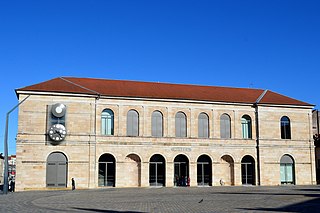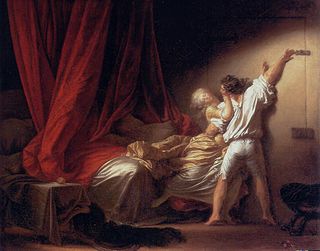A music lesson is a type of formal instruction in playing an instrument or singing.
Music Lesson may also refer to:
Lock may refer to:

Henri Émile Benoît Matisse was a French artist, known for both his use of colour and his fluid and original draughtsmanship. He was a draughtsman, printmaker, and sculptor, but is known primarily as a painter. Matisse is commonly regarded, along with Pablo Picasso, as one of the artists who best helped to define the revolutionary developments in the visual arts throughout the opening decades of the twentieth century, responsible for significant developments in painting and sculpture.
Bolt or bolts may refer to:
Swing or swinging may refer to:
Dance is an art form of coordinated bodily movement, typically to music.

Jean-Honoré Fragonard was a French painter and printmaker whose late Rococo manner was distinguished by remarkable facility, exuberance, and hedonism. One of the most prolific artists active in the last decades of the Ancien Régime, Fragonard produced more than 550 paintings, of which only five are dated. Among his most popular works are genre paintings conveying an atmosphere of intimacy and veiled eroticism.
The Red Room or Red Room may refer to:
The Dance may refer to:
The Reader is a novel by Bernhard Schlink from 1995

Dance is a painting made by Henri Matisse in 1910, at the request of Russian businessman and art collector Sergei Shchukin, who bequeathed the large decorative panel to the Hermitage Museum in Saint Petersburg, Russia. The composition of dancing figures is commonly recognized as "a key point of (Matisse's) career and in the development of modern painting". A preliminary version of the work, sketched by Matisse in 1909 as a study for the work, resides at MoMA in New York City, where it has been labeled Dance (I).
Joy of life may refer to:

Le bonheur de vivre is a painting by Henri Matisse. Along with Picasso's Les Demoiselles d'Avignon, Le bonheur de vivre is regarded as one of the pillars of early modernism. The monumental canvas was first exhibited at the Salon des Indépendants of 1906, where its cadmium colors and spatial distortions caused a public expression of protest and outrage.

The musée des Beaux-Arts et d'Archéologie in the French city of Besançon is the oldest public museum in France. It was set up in 1694, nearly a century before the Louvre became a public museum.

Marguerite Gérard was a successful French painter and print-maker working in the Rococo style. She was the daughter of Marie Gilette and perfumer Claude Gérard. At eight years old she became the sister-in-law of Jean-Honoré Fragonard, and when she was 14, she went to live with him. She was also the aunt of the artist Alexandre-Évariste Fragonard. Gérard became Fragonard's pupil in the mid-1770s and studied painting, drawing and printmaking under his tutelage. Gérard and Fragonard created nine etchings in 1778. Historians currently believe Gérard was the sole artist of five of these etchings since many have a duplicate created by her tutor Fragonard. More than 300 genre paintings, 80 portraits, and several miniatures have been documented to Gérard. One of her paintings, The Clemency of Napoleon, was purchased by Napoleon in 1808.
The Music Lesson is a 1917 oil painting by Henri Matisse.
The Piano Lesson depicts the living room of Henri Matisse's home in Issy-les-Moulineaux, with his elder son, Pierre, at the piano, the artist's sculpture Decorative Figure (1908), at bottom left, and, at upper right, his painting Woman on a High Stool. Matisse began with a naturalistic drawing, but he eliminated detail as he worked, scraping down areas and rebuilding them broad fields of color. The painting evokes a specific moment in time—light suddenly turned on in a darkening interior—by the triangle of shadow on the boy's face and the rhyming green triangle of light falling on the garden. The artist's incising on the window frame and stippling on the left side produce a pitted quality that suggests the eroding effects of light or time, a theme reiterated by the presence of the metronome and burning candle on the piano.
La Danse may refer to:
The Swing may refer to:

The Bolt, also known as The Lock, is a gallant scene painted by Jean-Honoré Fragonard in 1777. It is one of the most famous paintings by the painter. The common interpretation suggests that the scene depicts two lovers entwined in a bedroom, the man locking the door. The painting is preserved in the Louvre Museum, in the section of the Department of Paintings devoted to eighteenth-century French painting on the second floor of the Sully wing. It stands together with some of the most famous pictorial masterpieces of the same period, in a chronologically organized path. This painting, a true symbol of the libertine spirit of the 18th century, reflects the state of mind adopted by the painters of the era, notably that of François Boucher, one of Fragonard's teachers and a great representative of rococo painting.

The Music Lesson is a c.1770 oil on canvas painting by the French artist Jean Honoré Fragonard, now in the Louvre, to which it was donated by Hippolyte Walferdin in 1849.